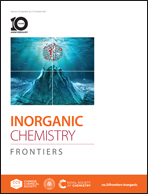A0.5H2C6N7O3·4H2O (A = Ca2+, Sr2+) iso-cyamelurates with ultra-large π-conjugated group and excellent nonlinear optical properties†
Abstract
Nonlinear optical (NLO) crystals are the core components of high-performance coherent sources. Their properties can be modulated and improved by molecular design of constituent functional motifs. In this study, inspired by a classical π-conjugated borate group (B3O6)3−, we discovered a π-conjugated isocyamelurate [H2C6N7O3]− anion with colossal π-conjugated orbitals, thus giving ultra-strong anisotropic first-order polarizability and ultralarge second-order susceptibility. Two new alkaline-earth metal isocyamelurates, namely, Ca0.5H2C6N7O3·4H2O (I) and Sr0.5H2C6N7O3·4H2O (II), were successfully synthesized by a facile aqueous solution method. Both I and II show excellent nonlinear optical properties, including wide band gap (>4.05 eV), large birefringence (Δn ∼ 0.24), and a strong second order harmonic generation response (>5 × KDP). Moreover, I and II exhibit a broadband ultraviolet photoluminescence around 400 nm, which indicate that they are potential multifunctional optical materials with photon-emission and photon-conversion properties. The first-principles calculations reveal that the (H2C6N7O3)− anionic group plays a dominant role in optimizing and enhancing the optical performance of the crystals. This study confirms that there are plenty of opportunities for (iso)-cyamelurates in designing functional crystals with superior properties.

- This article is part of the themed collection: FOCUS: Nonlinear Optical Materials


 Please wait while we load your content...
Please wait while we load your content...